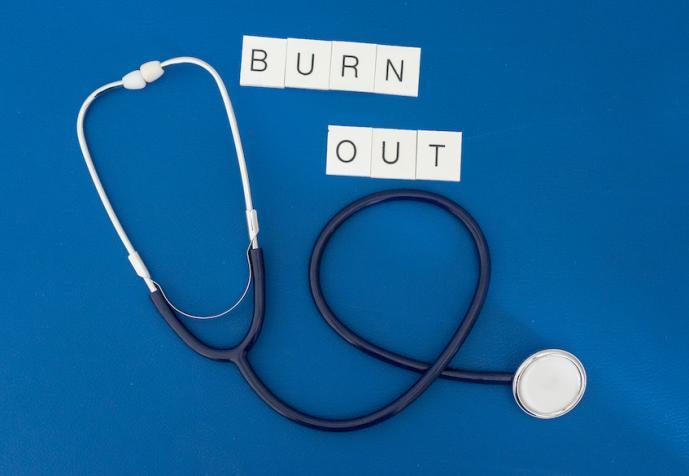
What is burnout?
It’s no secret that health care professionals run a high risk of burnout. With the arrival of COVID-19, health care professionals have experienced higher demands on their schedules and an increased focus on their performance measures. The intense emotional environment can take a toll.
Burnout can manifest itself in a number of ways. Feelings of exhaustion, disinterest, lack of compassion, cynicism and an impression of ineffective job performance are all symptoms of burnout.
The level of personal involvement, empathy and commitment to duty required in health care fields can negatively impact every profession within the health care industry. Physicians and nurses are at especially high risk of burnout but health care professionals such as occupational and physical therapists was well as occupational and physical therapy assistants and others are also subject to burnout.
Tobe Gillogly has more than 16 years of experience as a physical therapy assistant. She is also the chair of the Department of Interdisciplinary Health Studies in Ohio University’s College of Health Sciences and Professions and said all health care professionals can experience times of extreme stress which can impact their ability to provide optimal care for others and themselves.
“In a time where health care access, especially in rural and underserved areas, is challenging, health care professionals can feel that they are not able to do enough for their patients which is extremely frustrating and stressful,” Gillogly said. “Resources for those being cared for are another aspect that impacts burnout and in turn can lead to a feeling of helplessness for the health care professional trying to make a difference.”
Dangers of burnout
Burnout is certainly dangerous not only to health care professionals and their own well-being but also to the patients they see as well as the employers, family members and friends of health care professionals.
When experiencing burnout, health care professionals are prone to making mistakes. Medical errors affect the confidence and future performance of health care professionals and also affect health care facilities in terms of liability and reputation. Studies show higher levels of burnout negatively impact patient mortality and the spread of hospital-transmitted infections. Other studies point to burnout as a cause for a decreased sense of empathy toward patients, which can lead to lower patient satisfaction ratings. Alcohol abuse among health care professionals has also been linked to burnout.
In health care facilities with high occurrence of burnout, job turnover is prevalent, resulting in decreased workforce efficiency.
Burnout by the numbers
Studies show that more than half of physicians in the country experience burnout and that the rates continue to increase for health care professionals. A 2013 survey of more than 20,000 physicians reported a 40 percent burnout rate which increased to 51 percent in 2017, representing a 25 percent increase over the four-year span. Other studies also show an increase in burnout rates and note that physicians working in emergency medicine, gynecology, family medicine and other direct care specialties are at high risk and that female physicians are more likely than male counterparts to experience burnout.
Resident and medical students report exceptionally high rates of exhaustion, stress and fatigue. Studies have reported burnout rates between 70-78 percent for physicians in training while 44 percent of medical students report symptoms of burnout.
Cooling the burn
Like any medical condition, different solutions for burnout may work for different populations. Recently, the Mayo Clinic developed nine organizational strategies that resulted in a seven percent decrease in burnout over a two-year period.
These include:
- Acknowledge and access the problem
- Harness the power of leadership
- Develop and implement targeted interventions
- Cultivate community at work
- Use rewards and incentives wisely
- Align values and strengthen culture
- Promote flexibility and work-life integration
- Resources to promote resilience and self-care
- Facilitate and fund organizational science
Having a leadership team that recognizes burnout, its effects on employees and patients, and is committed to developing strategies to help is an important first step in reducing the impact and occurrence of burnout. The role of leadership can also extend to employees who take it upon themselves to make life changes in order to avoid burnout and to help fellow employees do the same. In some health care facilities, performance-based financial incentives have been found to drive burnout. As an alternative, awards such as time off and flexible work hours have been found to be beneficial.
Proper work-life management skills are imperative in fending off burnout as is professional fulfillment or job satisfaction. Studies show that health care professionals who spend at least 20 percent of work hours performing tasks they find fulfilling are significantly less likely to experience burnout.
Health care professionals can sometimes be the most difficult patients. In addressing issues such as burnout, stigma remains a constant hurdle. Fear of reprisal in the form of performance perception, judgment from peers and financial compensation are just some of the obstacles health care professionals may face when trying to address burnout. Leadership and health care organizations can assist with educational seminars, providing access to healthy-living tools — such as healthy food and exercise perks — and screening for signs of overwork and high stress.
Three personal strategies
The American Medical Association offers tips on personal strategies that may be helpful to reducing burnout, including:

- Maintaining healthy diet and exercise habits
- Take vacations that don’t involve constantly checking email and calendar items
- Talking to loved ones about work stressors
Whether the cause is a job that leaves little time for self-care or one that lacks challenge and variety, sometimes the answer is to find a career that is a better fit. Health professionals seeking a change in career path might consider additional education to equip them for roles in health administration or education. For example, allied health professionals who have an associate degree might consider completing an online Bachelor of Science in Integrated Healthcare Studies degree to compete for the many health care positions that require a bachelor’s degree. Nurses have many options as well, including pursuing a nurse leader or nurse educator MSN or post-master’s certificate or a Master of Health Administration degree. Ohio University’s College of Health Sciences and Professions offers these online programs and many more to help health professionals achieve and maintain a satisfying career. For more information, visit OHIO’s online program webpage today.
* * *
Sources:
https://www.ncbi.nlm.nih.gov/pmc/articles/PMC6367114/
https://www.mayoclinicproceedings.org/article/S0025-6196(16)30625-5/fulltext
https://www.ohio.edu/chsp/health-studies/bachelor-integrated-healthcare-studies

